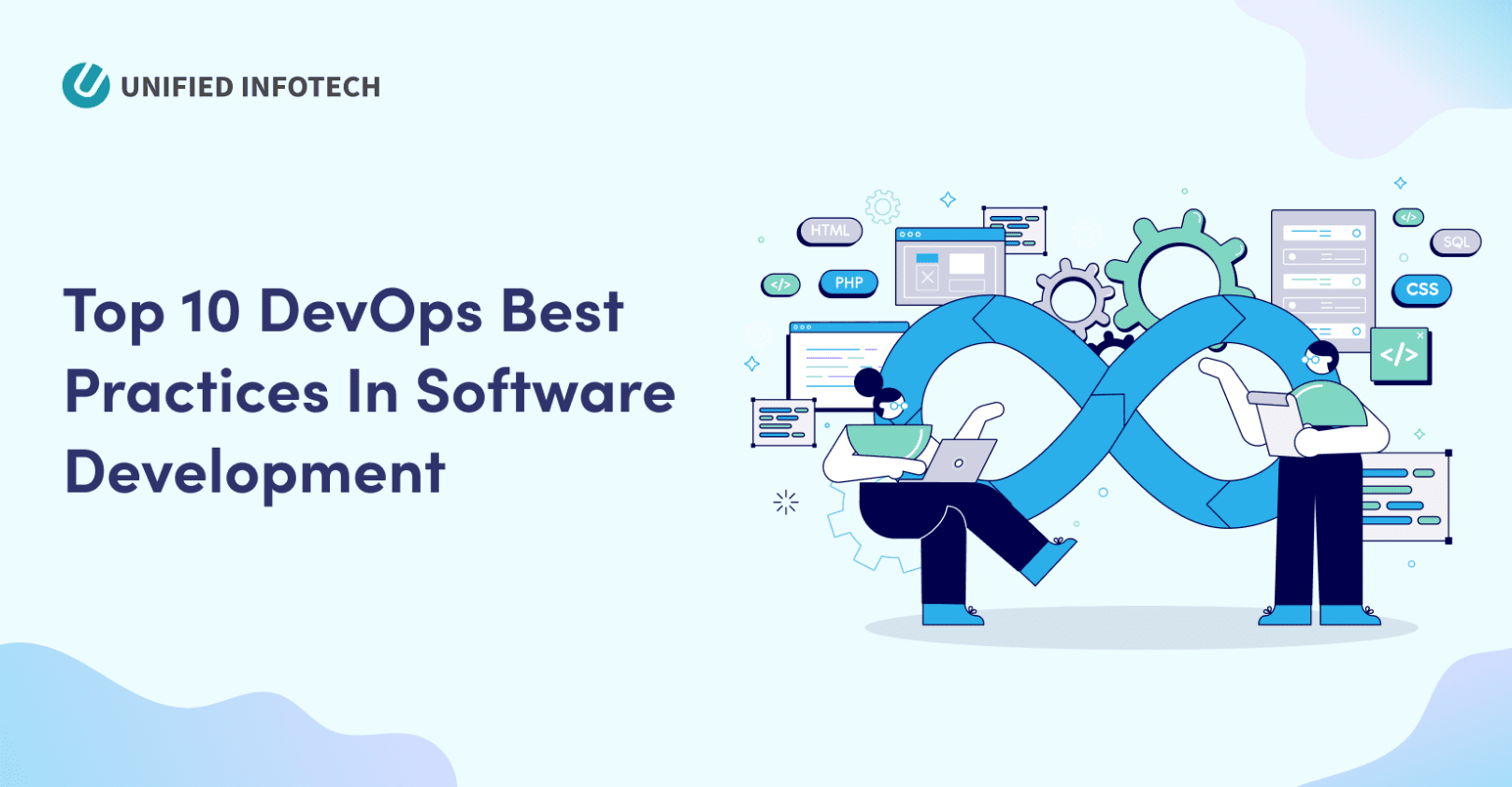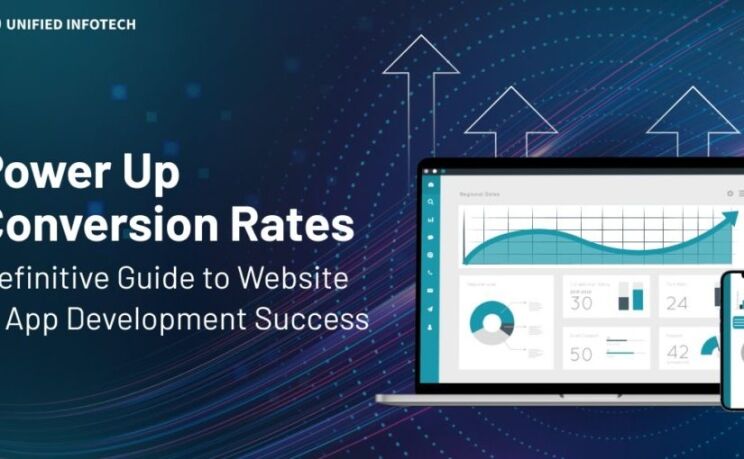Today, DevOps is no longer a buzzword. It is a pivotal technology that helps propel enterprises towards attaining digital transformation. The DevOps approach not only accelerates software solution development and delivery but also ensures high-quality standards throughout the entire lifecycle from development to deployment.
But that is not all. The DevOps synergy, a combination of secure, efficient processes and Agile principles, also helps foster unparalleled collaboration, coordination, and communication. These three Cs enhance project execution and delivery, making the SDLC more streamlined, cost-effective, and time-bound. Hence, DevOps offers a promising path of fulfillment for businesses intending to automate and optimize their operations and workflows.
Our blog aims to demystify DevOps. Decoding its best practices and maximizing their utility will help your business achieve newer heights and stay ahead in a fast-paced digital world. Join us as we embark on a journey to understand the DevOps best practices.

What Is DevOps?
While it is often interpreted as a development process, at its core, DevOps helps build a secure and collaborative environment. We can define DevOps as an initiative that aims to improve communication and cooperation between the two main software development verticals—development and operations.
This combination presents a new way of working that helps:
- Automate systems and workflows
- Enhance deployment speed
- Shorten the SDLC
- Deliver high-quality software
DevOps has witnessed a meteoric rise in popularity because it makes software development efficient and scalable. Today, many organizations and enterprises worldwide form lucrative partnerships with software development companies to take advantage of these benefits. A look at some recent DevOps statistics will help corroborate this point.
According to the DevOps Global Market Report 2024 available on Research and Markets, a leading research store for reports on industries, technologies, etc.
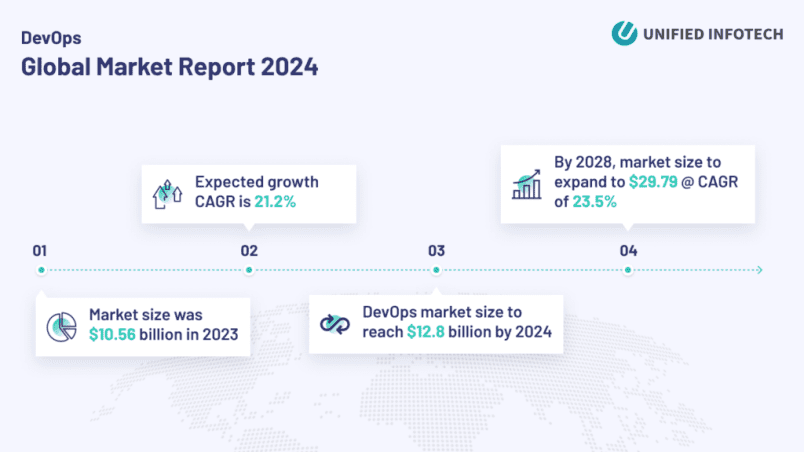
These statistics are not just numbers. They have been presented here with a purpose. While they testify to the immense popularity of DevOps, they also show the opportunities that exist. Ironically, despite the opportunities, most businesses hesitate to leverage DevOps. Perhaps the challenges they face in its adoption warrant such a response. But where there are challenges, there are solutions, too. So, let us explore the challenges involved and understand how adopting DevOps best practices can help overcome them.
Challenges involved in integrating DevOps

We know the benefits of adopting DevOps. But even the best DevOps practices come with some challenges that might potentially hinder its impact. To maximize the benefits, we must gain a brief overview of the challenges and seek solutions to overcome them. The important ones are mentioned below.
Lack of skilled personnel
DevOps engineers are in very high demand. Yet, sadly, only a few people possess advanced DevOps skills. DevOps is synonymous with continuous integration, deployment, and delivery. Hence, DevOps tech experts must leverage a wide range of technologies, tools, and automation approaches to facilitate this. However, the DevOps industry currently faces a massive talent crunch. This gap in demand and supply makes it difficult for software development companies to build top-notch DevOps teams.
Resistance to change
Unfortunately, implementing DevOps requires more than just undergoing an operational or technology change. The need for cultural change significantly impacts the initiation of any DevOps implementation plan. Organizations still cling to traditional siloed approaches for software development and find it challenging to adopt DevOps wholeheartedly.
Data management issues
Most DevOps teams are not skilled enough to assess and manage data, and they struggle to track the necessary information. Even the best DevOps companies must contend with this challenge.
Slow adoption by management
Custom software development now integrates advanced techniques like development sprints and microservices, which can be easily modified and deployed. However, delays occur due to long waits for reviews and approvals. Code, security, and operation reviews take a long time to complete. Further, the change control processes are also time-consuming.
Cybersecurity threats
Evolving security threats, such as advanced data breach methods and DDoS attacks, put all software solutions at risk. They require constant monitoring even after improved security processes are proactively integrated within the DevOps framework.
Needless to say, where there are challenges, there are bound to be solutions. Adopting the DevOps best practices provides a one-stop solution for all critical challenges mentioned above. Further, these best practices are well-defined and proven to yield results. Read on for further elaboration.
10 best practices of DevOps
What does best practice mean? Many businesses commonly ask this question. Before answering this question, let us briefly explore the need for adopting best practices.
Today, the digital landscape is ever-evolving and dynamic. You must adopt the best DevOps practices to remain competitive and deliver quality software quickly. With remote work still in vogue, understanding and implementing DevOps best practices helps improve communication and collaboration. This, in turn, will maximize the efficiency and effectiveness of these remote teams.
Let’s explore some insights and tips that will help businesses optimize resource use and enhance the SDLC.
Embracing Agile Management Techniques
DevOps is known for its dynamic and iterative nature. Agile project management technologies like Kanban and Scrum can easily facilitate rapid deployment and instant feedback loops, making them ideally suited for implementing DevOps best practices. Further, adopting agile practices helps software developers break down large and complex projects into smaller, easily manageable increments. Breaking the entire software development into sprints allows it to adjust quickly to evolving requirements and deliver value. Agile also emphasizes continuous collaboration and communication among teams, two factors essential for identifying and resolving issues quickly.
The core of agile is founded on four main principles:
- Prioritizing people over processes and tools
- Emphasizing software over documentation
- Preferring customer collaboration over contract negotiations
- Valuing adaptability to responsiveness over predetermined plan
This approach allows for continuous software improvement based on continuous feedback, a vital element of the DevOps approach. Thus, DevOps teams can adapt swiftly to changing user needs.
Merging agile with DevOps proves effective because it aligns software development with real-time user needs and online market demands. This collaboration ultimately results in the quick delivery of high-quality software, increased release frequencies, and fewer complexities during software development.
Building a Team-Centric Culture
Technicalities like Infrastructure as a Code(IaaC), containerization, automation, security, and continuous monitoring form the technical basis of all DevOps practices. But DevOps encompasses much more than all this. It embodies a culture that emphasizes collaboration and communication among two critical processes–development and operations.
Further, the unique DevOps culture promotes open communication and sharing of responsibilities, resulting in continuous improvement. This accelerates problem-solving, enhancing software quality and reliability. The resultant positive and productive work environment benefits both software development teams and organizations as a whole. By breaking down the development, operations, and quality assurance siloes, DevOps encourages transparency and unified accountability. This results in quicker time to market through faster development cycles.
Implementing DevOps helps truly transform organizations. It establishes a system of regular updates on progress, failures, etc., ensuring the development process stays aligned. Such transparency also boosts productivity and enhances operational efficiency. This approach not only meets customer needs and expectations but also supports the smooth transition of projects through the development process, embodying the DevOps principle of continuous integration and continuous delivery.
Optimal Tool Selection
Automation is a fundamental pillar of DevOps management. It simplifies the entire software development lifecycle, ensuring seamlessness and efficiency of the software building, testing, and releasing processes. DevOps tools play an indispensable role in the success of the implemented DevOps best practices. These diverse tools provide a variety of DevOps capabilities like:
- Tracking performance metrics
- Issuing alerts for operational anomalies
- Offering a comprehensive view of the SDLC
The result is an immediate feedback loop. This is vital to DevOps, where the speed of issue resolution directly impacts financial outcomes. Contrary to this, traditional software release processes involve multiple stages of testing and deployment, which can significantly delay response times. However, selecting the right DevOps tools allows for quicker reactions and better cost control. The multiple tools available, from version control systems to testing and deployment tools, might confuse businesses. However, it is essential that the choice of tools aligns with the business goals and integrates seamlessly with existing systems. Making the right choice will enable its proper utilization and maximize the returns from its DevOps initiatives.
Streamlining with CI/CD
Developers must implement a CI/CD pipeline to ensure DevOps success. This pipeline automates the different SDLC processes, enabling software developers to deliver codes swiftly and reliably. Further, it underpins the “shift-to-left” approach, where testing is integrated early into the code development process. Conducting varied tests throughout the development phase helps developers address bugs proactively and enhance their quality.
Continuous integration (CI) is one of the foundational DevOps pillars. CI facilitates the integration of code changes from different contributors into a central repository. Supporting this process with a source code version control system helps detect errors and quality issues in code segments more efficiently.
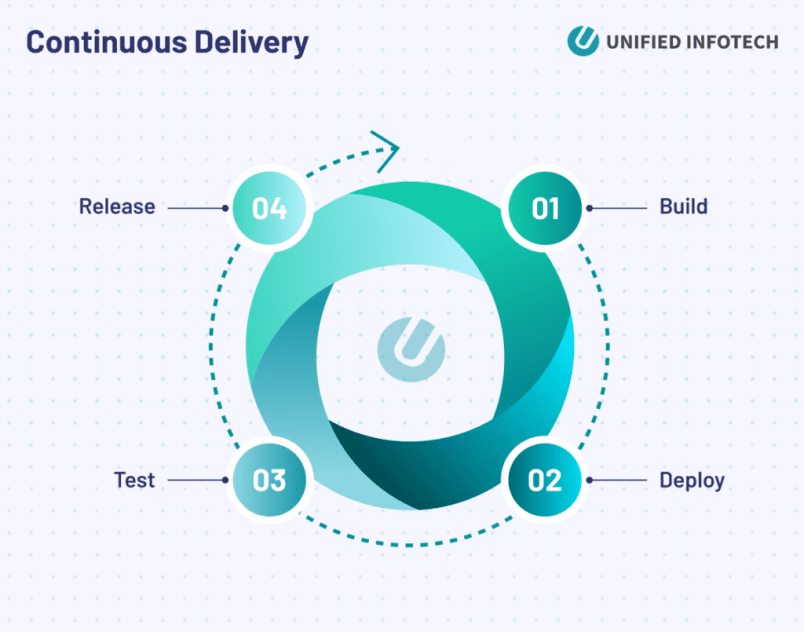
Continuous delivery, or CD, helps transition codes from integration to production environments. This simplifies the software deployment process and reduces associated risks, allowing their execution as and when required. Further, adopting CD as a DevOps best practice transforms complex app deployment into manageable, on-demand events.
The CI/CD pipeline is a popular DevOps concept because it automates builds and tests, provides immediate feedback on bug presence, and allows instant resolution. This setup not only facilitates extensive testing and upgrades but also helps preemptively identify any glitches.
DevOps orchestration tools play a significant role in CI/CD pipeline coordination. Automating the creation and management of multiple testing environments makes code testing simple and cost-effective. Thus, CI/CD intensifies the efficiency of the DevOps approach.
Shift-Left approach
What is the shift left approach in DevOps? It is a testing strategy that emphasizes continuous testing right from the early stages of software development. Rather than leaving testing activities to the final stages of software development, you can opt for a proactive approach and shift testing to the beginning. The idea is to identify and resolve defects as soon as they occur to prevent their propagation across the entire application, making testing more effort and cost-effective.
Bugs can also occur at any time throughout the software development process. Hence, it makes sense to incorporate continuous testing throughout all software development iterations. Testing along the way will mitigate risk and prevent further problems from cropping up and escalating.
Combining shift leg testing and continuous testing is, thus, a great way to improve software quality, optimize resource allocation and usage, meet user expectations, and mitigate the chance of bugs slipping into production.
Also, read our blog on Verification vs. Validation In Software Testing
Monitoring Essential Metrics
Observability is critical to understand system behavior and performance. Collecting and analyzing data from different touchpoints in the form of logs, metrics, and traces helps implement observability. Leveraging them allows software development companies to identify and address issues, make informed decisions, and improve software quality.
However, monitoring complex environments becomes increasingly challenging as software development progresses from monolithic, on-premise systems to microservice-based apps. Implementing observability helps overcome these challenges.
- Logs provide time-series data on system operations
- Traces help explain the flow of logic
- Metrics track resource usage and network connectivity
Together, they help make it easy to understand the functioning of complex systems.
Continuous performance monitoring is considered a best practice in DevOps. Tracking key performance metrics like lead time, mean time to detect, and issue severity helps gauge the effectiveness of the adopted DevOps methodologies. Further, monitoring these metrics allows for the rapid detection of issues and swift recovery. For example, metrics like unit cost help provide early insights to facilitate proactive project planning and cost optimization.
Adopting Microservices
Adopting the microservices architecture enhances the flexibility, scalability, and resilience of the developed software solution. This involves breaking an application into small independent services, each of which is developed, tested, and deployed individually. These services operate independently but are interconnected through an Application Programming Interface (API). This modular approach helps software developers deliver updates and upgrades more frequently. It also simplifies software scaling and maintenance.
Microservices form a core component of the DevOps methodology. They change how software developers approach development. Here, each service becomes an independent DevOps pipeline. Certain benefits that arise because of this shift include:
- Quick development and deployment
- Faster fault tolerance through quick resolution
- Improved overall system flexibility and reliability
- Drives continuous delivery by packaging each service as a container image
- Allows for selection of different tech stacks for different service
- Rely on APIs to communicate within services
- Allows for automation of all tasks
Microservices is custom-made for DevOps. It enables delivery teams to consider individual services as separate entities. Thus, combining the DevOps strategy with a Microservices architecture helps simplify development, testing, and deployment. This strategy allows different teams to work on separate services simultaneously without disrupting the functionality of the whole system. Furthermore, it also supports critical DevOps best practices like continuous integration and continuous delivery, agility, and software deployment efficiency. Ultimately, by moving developments to a flexible environment, developers can improve software quality and productivity.
Advancing Through Automation
Automation plays an integral role in DevOps, serving as a critical driver for efficiency, accuracy, and software delivery speed. The core concept is to automate routine tasks like code building and deployment, testing, monitoring systems, etc., to improve system efficiency and reliability. This further reduces the cost and effort, allowing DevOps teams to allocate time for more strategic and value-added activities. Automation is further augmented by CI/CD, another DevOps best practice. A CI/CD pipeline is automated right from the initial batching to frequent commits. This helps streamline code integration and deployment. Additionally, automated testing helps contribute to a robust development environment, encompassing a range of tests, including integration testing, unit testing, performance testing, etc.
Change management and IaC help maintain configuration and version control and promote operational consistency. Automating these processes further ensures that all stakeholders have access to the same code versions, enabling quick adaptation to configuration modifications.
Automation is now a necessity in DevOps best practices. It helps transform manual testinginto a quick and efficient SDLC. Numerous automation tools are available in DevOps, so software development teams can choose the best solutions that cater to their needs. This helps address all issues effectively. Consequently, the overall product quality improves.
Persistent Security Measures
The changing digital landscape makes it crucial for software developers to concentrate on adopting security DevOps best practices. They enhance security frameworks by integrating security tools deep within the CI/CD pipeline. Further, developers must use trusted and verified credentials for their software development. They must categorize codes based on their security requirements and priorities and fortify them with differentiated credentials. The entire security architecture can be further strengthened by developing test scripts to manage access rights.
Implementing the concept of continuous security will further augment this approach by facilitating a seamless transition to DevSecOps. Proactively incorporating security best practices and tools like secure coding, proactive logging, and alerting will reduce the risk of breaches and enhance user trust. Security is a foundational aspect of the DevOps SDLC. Prioritizing DevOps security best practices will make the solution more secure, efficient, and reliable.
Ongoing Feedback Collection
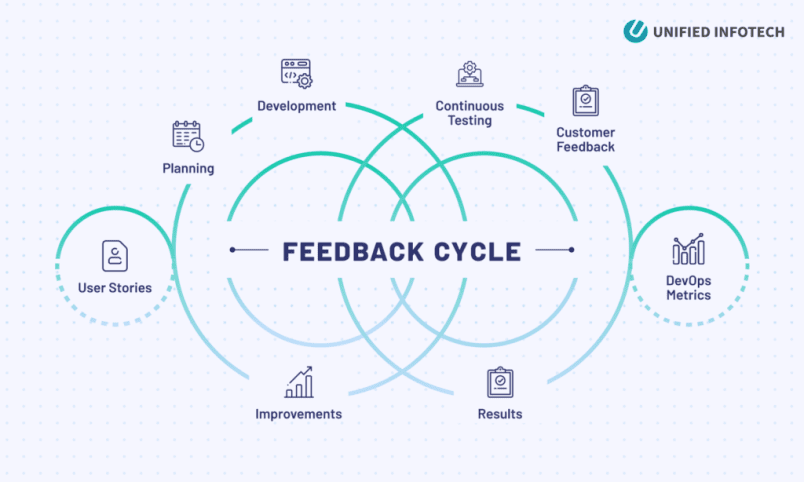
This serves as a means of understanding user mindsets and integrating the gathered insights to improve the efficacy and quality of the software developed. It must be an iterative process aligned with the core objective of continuous improvement inherent to the DevOps approach.
Continuous feedback helps relay development failures, performance issues, integration hitches, and defects promptly to the product management team. This system not only speeds up the development process but also significantly elevates the quality of the final product.
Further, continuous feedback fosters a culture of optimization and ongoing improvement within teams. It helps teams align more closely with the real-time needs and desires of their target audience. This responsiveness results in the prioritization of features, proper allocation of resources to critical fixes, and improved customer satisfaction.
Collaboration is a crucial concept of DevOps. Gathering continuous feedback encourages collaboration among developers, operations staff, and other stakeholders. This unified approach to problem-solving leads to more resilient, agile, and responsive development systems and quicker time-to-market.
Adopting these strategies will ensure that software development teams can successfully navigate the challenges of modern software development. They can also foster a culture of feedback and continuous improvement. Further, they will help client businesses thrive in an increasingly digital world.
UIPL DevOps: How we leverage DevOps Best Practices in software development
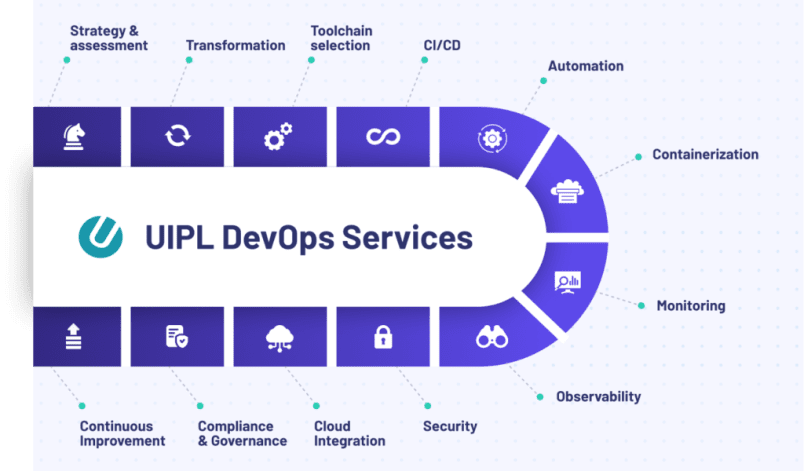
We at Unified Infotech leverage modern DevOps practices to implement industry best practices for software development. We offer a broad spectrum of DevOps services, consultations, and solutions. When referring to UIPL DevOps, we refer to the processes and strategies we provide as services to businesses seeking to implement DevOps. Let us briefly explore the services we offer and the critical DevOps questions it answers.
Strategy and Assessment
How do we help you define your DevOps strategy? By assessing and analyzing your current development and operations workflows to identify critical areas of improvement. This analysis is very comprehensive and includes an evaluation of all existing tools, technologies, workflows, and company culture.
Transformation
How do we bring about the DevOps transformation in your business? By breaking down existing silos and promoting cross-functional collaboration, and augmenting this with process automation and a culture promoting continuous improvement. This will help transform traditional software development and make it more streamlined and effective.
Toolchain Selection and Integration
How do you know which integration tools to select? Modern DevOps practices dictate that we choose the right CI/CD tools, automation frameworks, version control systems, and other relevant technologies to ensure DevOps success. Our cumulative experience and expertise will help you to make the right choice and maximize earned benefits.
CI/CD
How do you shorten software development cycles? By setting up CI/CD pipelines to automate different software development phases. Hence, we will integrate tools that automate development, testing, QA, and deployment. This results in quicker releases and improved software reliability and quality.
Automation
How do we achieve automation? We have an excellent technical team that develops custom software. They curate bespoke solutions based on your workflow requirements to automate repetitive tasks. Further, automation forms the core of all DevOps methodologies. Automation will help businesses deploy applications, manage configurations, and provision infrastructure.
Containerization and orchestration
How to properly adopt containerization technologies? We help organizations adopt all tools and technologies that form the pillars of DevOps. Examples include Kubernetes, a container orchestration platform, and Docker, a containerization platform. Adopting these tools helps improve application scalability and deployment.
Monitoring and observability
How to ensure the reliability of custom software applications? We always emphasize including monitoring and observability whenever we implement DevOps. These DevOps monitoring best practices help us log solutions and improve app health and performance based on the same.
Security
How to overcome cybersecurity challenges in DevOps? By leveraging DevOps security best practices, we implement techniques like code scanning, secure configuration management, and vulnerability assessments.
Cloud integration
How to integrate the cloud into DevOps practices? Since cloud adoption is a part of many DevOps initiatives, we insist on incorporating cloud services like Google Cloud Platform, AWS, and Azure.
Compliance and governance
How do we ensure that your application complies with relevant rules and regulations? By researching the applicable regulations and compliances, we will integrate them into our DevOps framework. Ensuring compliance with the appropriate regulations at every phase of the software development lifecycle will help us ensure governance of your custom software.
Continuous improvement
How will we keep your website updated? Continuous improvement is integral to DevOps. We will establish this by implementing techniques like feedback loops, KPIs, metrics, etc. Further, we will leverage the insights gathered from their analysis to foster an environment of continuous improvement.
At Unified Infotech, DevOps is a way of developing agile, adaptable, and collaborative software. It helps us cater to the diverse needs of the industries we serve and the audience niches relevant to our clients. For us, DevOps is a vital tool for enhancing efficiency and productivity for our clients. In a rapidly evolving and fiercely competitive digital landscape, custom software solutions developed using DevOps technologies help our clients survive and thrive profitably.
Conclusion
Referring to DevOps as a technology is a misnomer. It represents a unique convergence of philosophies, practices, and tools that work unitedly to enhance the speed, quality, and agility of business innovation. The DevOps platform serves as a great facilitator. It is a collaborative backbone that app developers and other IT professionals leverage to bridge gaps and streamline workflows. As a result, the entire software development lifecycle gets streamlined, showing greater scalability and availability while offering a more stable operating environment. Further implementing DevOps best practices results in greater automation of the processes and better resource utilization. As a result, this imparts greater transparency into system outcomes and results in faster and better product delivery.
Frequently Asked Questions:
Two critical aspects that influence the success of integrating DevOps include selecting the right DevOps team and implementing appropriate DevOps best practices. While having a skilled team will improve the software development process, implementing the best practices will streamline the process and give it the necessary boost. This will enhance the chances of success.
DevSecOps is a relatively new concept that involves implementing DevOps security best practices throughout the software development cycle. This concept integrates the traditional siloed security process within DevOps, bringing together development, operations, and security teams and fostering an environment of continuous security.
Yes.
Skill gap is a significant challenge faced by all software development companies adopting the DevOps approach. But at Unified Infotech, we maintain a team of DevOps professionals, each experienced in their respective expertise. This helps us handle all configuration and infrastructure changes without disrupting the current system.
Transitioning from the traditional to the DevOps approach can cost anything between $100,000 to $500,000. However, the actual cost depends on the project requirements because many free and open-source tools are available online.
Adopting DevOps best practices will help streamline the software development process. Leveraging CI/CD pipelines, automation, continuous security, continuous feedback, and continuous improvement will ensure high-quality software releases and reduce the time to market.



